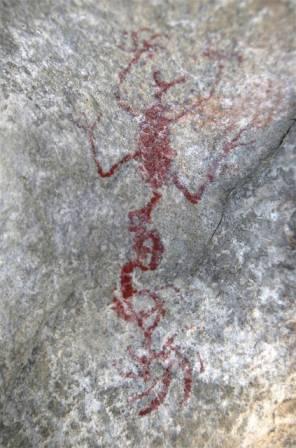Chumash Rock Art - Passport in Time
Main menu:
Previous Projects > States A-F
Range and Rock Art
 The U.S. Forest Service has areas where cattle grazing is allowed. The areas are leased for a certain amount of time, and the property is assessed for impact from the cattle before a new lease is issued. On the Sierra Madre Ridge, it was time for that assessment. Therefore, the primary purpose of this project was to assess cattle damage to prehistoric sites; those sites most likely to be impacted by cattle were given high priority. Over four square miles of this area are with the Eastern Sierra Madre Archaeological District, registered with the National Register of Historic Places (NRHP), so sites with incomplete and/or no recordation were also targeted. Formal surveys were conducted on selected unsurveyed areas and on areas where new sites were discovered.
The U.S. Forest Service has areas where cattle grazing is allowed. The areas are leased for a certain amount of time, and the property is assessed for impact from the cattle before a new lease is issued. On the Sierra Madre Ridge, it was time for that assessment. Therefore, the primary purpose of this project was to assess cattle damage to prehistoric sites; those sites most likely to be impacted by cattle were given high priority. Over four square miles of this area are with the Eastern Sierra Madre Archaeological District, registered with the National Register of Historic Places (NRHP), so sites with incomplete and/or no recordation were also targeted. Formal surveys were conducted on selected unsurveyed areas and on areas where new sites were discovered.
Los Padres National Forest, California, 2009
July 13-17; 24-26; August 10-14; 28-30, 2009
 The U.S. Forest Service has areas where cattle grazing is allowed. The areas are leased for a certain amount of time, and the property is assessed for impact from the cattle before a new lease is issued. On the Sierra Madre Ridge, it was time for that assessment. Therefore, the primary purpose of this project was to assess cattle damage to prehistoric sites; those sites most likely to be impacted by cattle were given high priority. Over four square miles of this area are with the Eastern Sierra Madre Archaeological District, registered with the National Register of Historic Places (NRHP), so sites with incomplete and/or no recordation were also targeted. Formal surveys were conducted on selected unsurveyed areas and on areas where new sites were discovered.
The U.S. Forest Service has areas where cattle grazing is allowed. The areas are leased for a certain amount of time, and the property is assessed for impact from the cattle before a new lease is issued. On the Sierra Madre Ridge, it was time for that assessment. Therefore, the primary purpose of this project was to assess cattle damage to prehistoric sites; those sites most likely to be impacted by cattle were given high priority. Over four square miles of this area are with the Eastern Sierra Madre Archaeological District, registered with the National Register of Historic Places (NRHP), so sites with incomplete and/or no recordation were also targeted. Formal surveys were conducted on selected unsurveyed areas and on areas where new sites were discovered.The project was planned for July and August, 2009. Two week-long and two extended weekends were coordinated with PIT volunteers. The groups camped at Painted Rock Campground so that time would not be lost traveling. Unfortunately, one of the week-long trips was cut short to three days because of danger from the La Brea Fire. Before we evacuated, however, we cleared all vegetation from the area around the paintings on Painted Rock to protect them if the fire actually got that fire. Fortunately, it didn't.
A total of 23 site records were updated, 7 new isolates were recorded, and 7 new sites were discovered and recorded. Within the previously-recorded sites, the crews found unrecorded elements. A concentration of bedrock mortars associated with a known habitation area was discovered as well as additional BRMs and rock art at another site. Two previously unsurveyed areas were carefully surveyed at 5-meter intervals: the sloped area to the west of the private inholding on Salisbury Potrero, and the entirety of Rattlesnake Potrero. In addition, an area between 57-40 and the Sierra Madre Road was surveyed when historic artifacts were discovered. Recording (and updating) sites involved the use of GPS for exact locations, measurements of sites and features, drawing, and photography.
The months of July and August are very hot on the protreros, but the volunteers stepped up to the challenge. There were some strenuous hikes, hot rocks, the ever-present possibility of meeting a rattlesnake, and limited clean-up facilities, but everyone survived. We potlucked for dinner and had some great food. Dick Gibford, a resident cowboy on the potreros and a well-known cowboy poet, recited for us at three of the sessions.
We feel that the project was extremely successful. We also feel that we could not have done it without our wonderful volunteers! The Passport in Time program is not just a great experience for the volunteers, but a tremendous help for archaeologists. Our volunteers made the Range and Rock Art project happen!